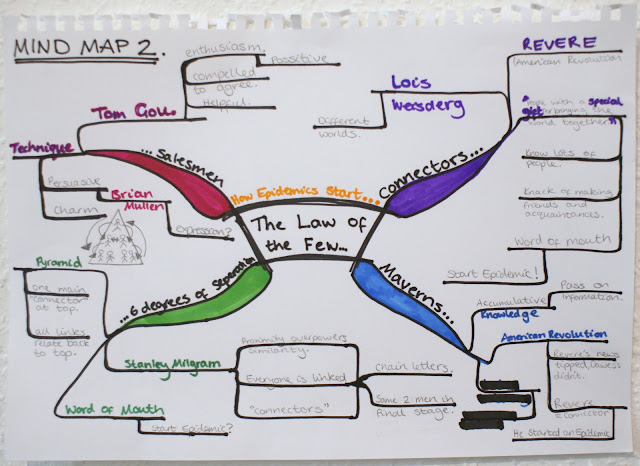Semester One of Design Studies
Assignment One
Honestly, I didn't particularly enjoy the book when I read it a couple of months ago, although, I agree Gladwell makes many valid points as to how ideas reach a certain point. A "tipping point". I particularly appreciated how he explored to three key factors that are involved in encouraging an idea to spread and found the comparisons drawn between the spread of ideas and physical things such as viruses or crime valid.
We were asked to complete two mind maps. One on the book as a whole and one one an area of choice. My maps are very much still a working progress as I am currently re-reading the book and admittedly, enjoying it slightly more second time round. I feel I'd rather focus my second mind map on a more specific area, perhaps on the experiment by Stanly Milgram or the relating subject of the Six Degree's of Separation which I find intriguing. Anyway, here's what I've come up with so far...
Bibliography
The Law of The Few (Chapter Two)
Page 30:
Fischer. D.H. (1994). Paul Revere's Ride. New York: Oxford University Press.
This reference gives background on Paul Revere in relation to the American Revolution. It highlights his march to Lexington and how Revere started a word of mouth epidemic. Gladwell explains how Revere’s news “tipped” where as Dawes didn’t due to differences in person. Revere was a connector and a mavern.
Page 34:
Milgram. S. (1967). The Small World Problem. Psychology Today. Vol. 1, p.60-67.
Six degrees of separation chain letter test. 160 people from Omaha to get their letter to a stockbroker in Sharon using relatives or friends who they believe can pass the letter on until it reaches the final destination. 24 made it with 3 main connectors delivering the letters.
Kochen. M. (1989). The Small World Problem. New Jersey: Ablex Publishing Corp.
Relates to The Six degrees of separation.
Page 35:
Werner. C, Parmlee. P. (1979). Similarity of Activity Preferences Among Friends: Those Who Play Together Stay Together. Social Psychology Quarterly. Vol. 42 (1), p.62-66.
Study showed most of the people living in the Dyckman projects in N. Manhattan shared a building with their best friends. People chose friends of similar ages and races. The University of Utah found that people favour making friends who live in close proximity to them rather than people who are similar to them. Gladwell agrees with this conclusion.
Page 47:
Tjaden. B. Brett Tjaden Project. Available: www.cs.virginia.edu/oracle/.
Tjaden created calculations to work out most connected actor, at the Univ. of Virginia. "Six degrees of Kevin Bacon" game. This relates to the Six Degrees of Separation discovered by Milgram.
Page 53:
Granovetter. M. (1995). Getting a Job. Chicago, USA: University of Chicago.
Where only 20% applied directly, sociologists found that over half of the workers used connectors to find their job.
Page 60:
Inman. J.J, McAlister. L, Hoyer. W.D. (1990). Promotion Signal: Proxy for a Price Cut? Journal of Consumer Research. 17, p74-81.
Page 61:
Feick. L.F, Price. L.L. (1987). The Market Maven: A diffuser of Marketplace Information. Journal of Marketing. Vol. 51, p83-97.
Price filmed interviews with several Mavens.
Higie. R.A, Feick. L.F, Price. L.L. (1987). Types and Amounts of Word-of-Mouth Communications About Retailers. Journal of Retailing. Vol.63 (no.2), p260-278.
Research into how Mavens shop.
L.L. Price, L.F. Feick & A. Guskey. (1995). Everyday Market Helping Behaviour. Journal of Public Policy and Marketing. Vol.14 (2), p225-266.
Research into the personalities of Maven.
Page 74:
Mullen et al. B. (1986). Newscasters' facial expressions and voting behaviour of viewers: Can a smile elect a President? Journal of Personality and Social Psychology. Vol.51, p291-295.
This reference shows that facial expressions are important and they have the ability to persuade people.
Page 77:
Wells. G.L, Petty. R.E. (1980). The Effects of Overt Head Movements on Persuasion. Basic and Applied Social Psychology. Vol.1 (3), p219-230.
Persuasion doesn’t need to be obvious to work. It can be subtle. Students told to nod or shake their heads while "testing" headphones that played messages about rising education fee's.
Page 84:
Hatfield. E, Cocioppo. J.T, Rapson. R.L. (1994). Emotional Contagion. Cambridge, UK: Cambridge University Press.
This book claims humans infect each other with their emotions. Emotion can spread from one person to another rapidly.
Page 85:
Friedman. H. (1980). Understanding and Assessing Nonverbal Expressiveness: The Affective Communication Test. Journal of Personality and Social Psychology. Vol.39 (2), p333-351.
Test aiming to measure ones emotional "contagiousness'. Highest mark is 117 with Tom Gau an example salesmen scoring 116.
Friedman. H, Riggio. R. (1981). Effect of Individual Differences in Nonverbal Expressiveness on Transmission of Emotion. Journal of Nonverbal Behaviour. Vol.6, p96-104.
Gladwell uses this source to back up his belief that emotion is contagious. Just like the yawning he describes in his introduction to the book.


No comments:
Post a Comment